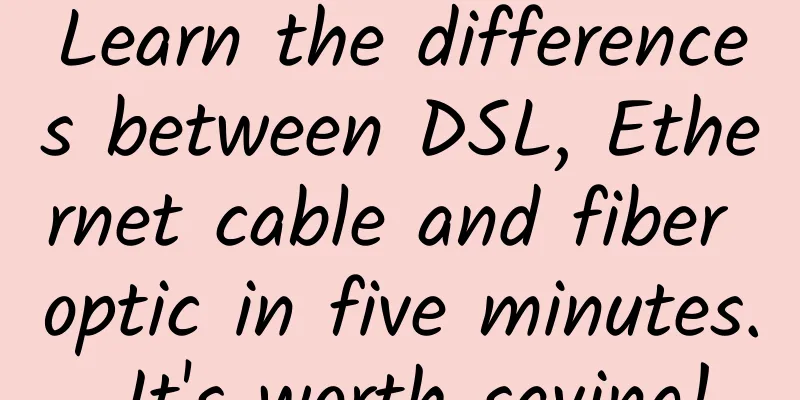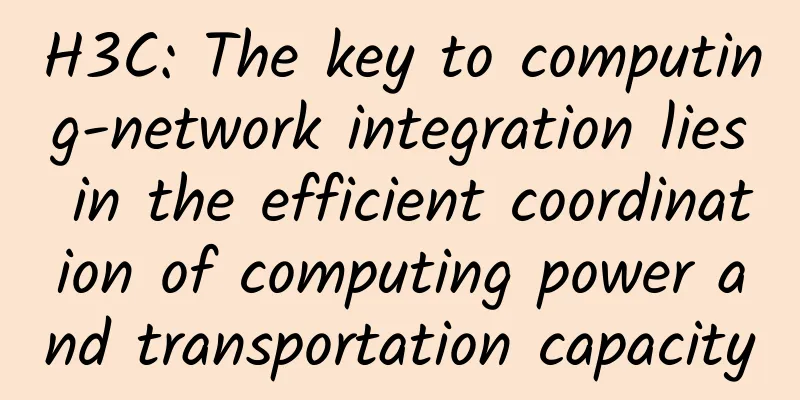Learn the differences between DSL, Ethernet cable and fiber optic in five minutes. It's worth saving!

|
This article will explain the differences between DSL, Ethernet, and fiber optic. 1. What is DSL cable?DSL is a broadband access technology that uses telephone lines as transmission media. There are many modes of DSL, including HDSL, SDSL, VDSL, ADSL, and RADSL, collectively referred to as xDSL. Among them, HDSL and SDSL are symmetrical transmission, that is, the upload speed is the same as the download speed, while VDSL, ADSL, and RADSL are asymmetrical transmission, that is, the upload speed is inconsistent with the download speed. DSL cable is also called telephone cable. It has two, four, six and eight cores, and four cores are usually used. Two cores are analog electronic signals, and four cores are digital telephone signals. For home use, two-core telephone lines are usually used. If it is used by a company or enterprise, four-core telephone lines are usually used. If you are using a digital phone, six-core telephone lines are usually used. Telephone wires are usually made of copper. 2. What is Ethernet Cable?Ethernet cable is also called network cable. A network cable usually consists of four pairs of copper core twisted pair wires and uses RJ45 connector. Network cables are generally divided into STP and UTP, among which UTP network cables are the most frequently used. Currently, Ethernet cables are divided into
The maximum transmission rate is 40 Gbit/s and the maximum transmission distance is 100 m. The following table lists the differences between network cables. 3. What is optical fiber?Optical fiber is made of glass fiber and uses the principle of total reflection of light to transmit data. Optical fibers are divided into multimode fibers and single-mode fibers. Multimode fibers use a wavelength of 850 nm or 1310 nm for short-distance transmission, while single-mode fibers use a wavelength of 1550 nm for long-distance transmission. Generally speaking, optical fiber has the following advantages: 1. Large bandwidth and capacity Compared with traditional copper cables and electrical cables, optical fiber transmission has a larger bandwidth, and the optical fiber transmission principle improves the transmission capacity of the cable through various complex technologies. 2. Low loss and long relay distance Silica fiber has lower losses than other transmission media currently in use, which also means that fiber optic transmission systems span more relay distances. 3. Strong anti-interference ability Quartz is the raw material of optical fiber. It is an insulating material with insulating properties, is not easy to corrode, and is not affected by electromagnetic interference. 4. No crosstalk, good confidentiality The outer cladding structure of the optical fiber absorbs leaked light, prevents the leakage of light wave signals, prevents crosstalk between adjacent cables, and prevents information from being eavesdropped. 4. Comparison of DSL, Ethernet cable, and fiber opticDSL is an early product of the Internet, suitable for broadband access to home networks, but it has gradually been phased out and replaced by Ethernet cables. To date, Ethernet cables have played an important role in wired networks. Fiber optics is widely used due to its advantages, especially in areas with high bandwidth requirements such as data centers. Material Both DSL and Ethernet cables use a copper core, while fiber optic cables are made of glass fibers. Transmission Mode DSL and Ethernet lines transmit signals in the form of electrical pulses, while fiber optics transmit signals in the form of pulses of light. Transfer rate If VDSL is used, the maximum downstream rate can reach 52Mbit/s. The transmission rate of Ethernet cable can be 1000 Mbit/s, 10 Gbit/s, or even 40 Gbit/s. The transmission rate of optical fiber is much higher than that of network cable. Transmission distance The transmission distance of DSL does not exceed 5.5 km (RASDL). The theoretical transmission distance of Ethernet cable is 100 m. The theoretical transmission distance of Category 8 network cable is only 30 m, the transmission distance of single-mode optical fiber can reach 10~20 km, and the transmission distance of multi-mode optical fiber can reach 2~3 km, which is much higher than the transmission distance of Ethernet cable. Safety Optical fiber is made of quartz stone, which has good security and anti-interference properties. Therefore, optical fiber is safer than DSL and Ethernet cables. V. ConclusionDSL, Ethernet cable, and optical fiber are the three cables we are more familiar with. Among them, DSL will gradually withdraw from the stage of history. Ethernet cable and optical fiber are currently the most frequently used. This article introduces what DSL is, what Ethernet cable is, and what optical fiber is. Finally, a comparison is made. I hope this article will help you understand DSL, Ethernet cable, and optical fiber. |
<<: Three steps to protect your home network
>>: Let’s talk about the complete guide to HTTP status codes. Have you learned it?
Recommend
[11.11] Spinservers cloud server 50% off $19/month, dual core, 8G memory, 200G SSD, 10TB monthly traffic
spinservers has launched a promotion for Double 1...
Singapore to shut down 3G and reallocate spectrum for 5G
Singapore will shut down its 3G network in July n...
I am confused. If I want to store IP addresses, what data type is better?
When it comes to IP addresses (IPv4), common IP a...
Why does 6G run so fast?
The latest 6G speed created by Chinese scientists...
Huawei redefines data infrastructure. Here are the answers to five questions that the industry should be concerned about!
[51CTO.com original article] On May 15, Huawei re...
How 5G can help realize massive IoT
When discussing the coming 5G era, attention is o...
5G networks need to overcome three major barriers to large-scale commercial use
Although 5G licenses have been issued, the commer...
XenSpec: Chicago/San Jose 1Gbps Unlimited VPS Starting at $2.95/month
XenSpec is a foreign hosting company registered s...
China's Internet world under the epidemic is being "mirrored" around the world
DingTalk made its debut in Japan. "Well... t...
No need for WiFi, can you surf the Internet with light? China releases the first visible light communication chip
No need for WiFi, can you surf the Internet with ...
The epidemic has accelerated the release of policy dividends, and the Internet of Things has ushered in new opportunities for development
Under the severe constraints of the COVID-19 epid...
An in-depth review of five common WiFi installation solutions to determine which one is better!
Choosing a wireless WiFi coverage solution is jus...
Current status of Chinese domain names: low application level and potential security risks
Recently, at the Second China Domain Name Develop...
Five signs SCVMM isn't right for your data center
Today, System Center Virtual Machine Manager (SCV...
Runqian Software and Yonghong Technology signed a strategic cooperation agreement
[51CTO.com article] On November 8, 2017, Runqian ...









